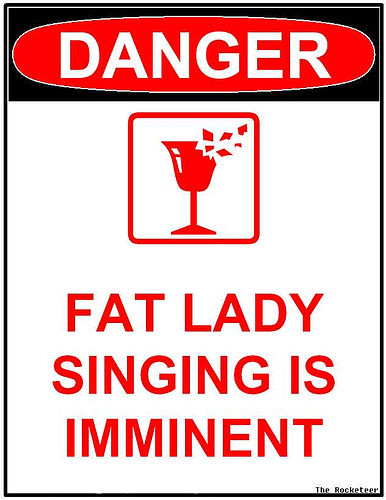The words on everyone’s lips seem to be “Is the recession over yet?” and yet no common answer seems to be forth-coming. Is it still going and are we still in it? Was it short lived and relatively benign, or is it more of an indication of fundamental structural failures within our modern banking model? Who knows? Who do we trust to know? If people couldn’t tell us how we got into it, then why should we trust them to tell us how to get out? If it’s not over now, then when will it be over? Is it really just a case of timing? As the tired, sexist, weightist, anti-operatist and counter-elitist saying in the title goes, “It ain’t over till the fat lady sings”.

So if we’re talking recessions and architecture; and an end to one but not the other: what is our ‘fat lady’, and when will she sing? There will be quibbles and objections to any such saying, none-the-least by those of us who would question: why does the lady have to be fat, or why is she a lady and not just a woman, or even why does she have to be a woman and not a man? Why is she singing, why is she not just talking, what is the relevance of song and weight to recessions and architecture anyway? Who says she is fat and why can she not just be allowed to be comfortable in her own body without media manipulation of bodily mass expectations, and misogynistic societal imagery of traditional work roles such as subservient singing roles? Why such a reinforcing look at stereotypical attitudes of gender politics and work roles within the straightened roles of women in modern society? Why shouldn’t women sing when they want and who says that any outcome should be reliant on whether they want to vocalise or not? Are they being paid to sing or is this another case of typical male presumption that women will voluntarily take on extra unpaid work as part of the baggage of pressure that women are expected to bear as part of the male-dominated society we live in, and speaking of male dominated societies, why is architecture such a male thing and women not recognised as equals and paid as such?
However, all that aside, I just wanted to post up a picture and video of Aretha Franklin, and as it’s our blog, she’s our hero, and we can post what we like, and she’s fat and still singing, and so we think that’s relevant, and so we have: then so there.

There is another fantastic video that has recently come to my attention – to some of you it will be old hat, yet it is still worth reconnecting to here before it disappears into the ether of the interwebz.
The Crisis of Credit Visualized from Jonathan Jarvis on Vimeo.
It is by a young man in the US, who took it on as a design project to try and explain what was happening with the world financial markets as they melted down around him: various critics have berated him for not getting it exactly right, and yet the graphic output of his work here is superbly more coherent than any amount of financial strategists may care to elucidate. It shows at last one worth of design in a field not traditionally known for it, and that good clear design can be a way forward for many different fields – none the least of which is architecture. It is worth watching all the way through for its simple setting out of the complex world of financial derivatives that we do not have so much here – and therein, back to the point of this blog posting.
I’m surprised that the NZ economy has held out and performed as well as it has, despite a doubling in the numbers of our unemployed and unemployable, and a crashing and virtual stagnation of our housing market that shows signs of crawling back to life, given that the rest of the world (without which we could not survive) has taken a hammering of a magnitude beyond comprehension. International money markets have been smashed, yet are piecing themselves back together now; bankers have been demonised and publicly flagellated, yet are paying themselves bonuses again; architects have suffered loss of work yet have not gone wholesale to the wall as they have in past recessions. Has this been a Clayton’s recession after all? Are the fabled green shoots of recovery pushing up through the crusty soil of our fragile spring?

And so, in a roundabout way, we get to the real point of this posting – but no, I’ve gone on for too long, and the sun is shining, and I need to get out to the harbour and spread my little fins in the water. It may be time, but I’ve run out of time. Perhaps tomorrow I’ll elucidate. In the mean time, ponder this: what makes up the fabled phrase we now hear said so much: “Design Excellence”? What is it, and who judges it?




Design Excellence is one of those phrases that is well over-used. Like the phrase Going Forward it doesn’t really mean anything
Duster: can you suggest a fresher, more meaningful term? At first glance, the meaning would seem to be clear enough, in that rather than just being “good design”, which will often imply a modest, well-thought-through solution to a straighforward design problem, “design excellence” suggests a level of creativity, innovation and flair that goes beyond being “just good enough”.
However, beyond the fact that one person’s excellence is another’s excrescence, there’s the question of scope. Is it just the external appearance that matters? Or should such things as internal amenity, environmental sustainability, efficiency of planning and structural ingenuity come into it?
In the case of a competition, it’s up to whoever sets the brief to decide, and the criteria would usually consider most of those factors. However, I imagine you’re referring to the urban design assessment of over-height buildings in central Wellington, and while there are no specific definitions of “design excellence” in the District Plan, there’s a strong suggestion that visual appearance is the primary focus.
The relevant DP rule is 12.2.5.5, and among other things it says that “To ensure that over height buildings visually enhance the cityscape of the Central Area, the council will require that they display design excellence”. It goes on to explain that because a building that stands out from its surroundings will be highly visible, it has more responsibility to make a positive visual contribution than one that fits in more modestly to the urban fabric. On the other hand, while not explicitly stated, it would seem that the other aspects of the design must be more than just “good enough”, and some other qualities (such as provision of public amenities) might go towards an understanding of excellence. But since the trigger is height, visibility is the key criterion, and buildngs “should display a quality of design that corresponds appropriately to their level of visibility”.
That needn’t mean that the building must should “Look at me! Look at me!”, and an elegantly-proportioned, exquisitely-detailed building is often better than one that’s going out of its way to be wacky and creative. Thus, it may be good that there are no explicit criteria for “excellence” laid out in the DP: after all, there is no checklist for excellence.
So that comes down to your last question, “who judges it?”. In the first instance, it’s the Council’s Urban Design team that makes the judgement, usually with advice from external advisors with specific architectural expertise. But buildings that significantly exceed height standards are often notified, so the final decision would come down to the Commissioners, or the Environment Court if the decision is appealed.
Is this the ideal situation? Maybe not, and there’s always a danger of the Council either erring on the side of becoming architectural police or of being swayed by persuasive architects and developers. But while architectural expertise is certainly vital in making the assessment, it’s important to note that it’s _not_ an architectural competition. The underlying criterion is not “is this excellent architecture?”, but “does this building make an excellent contribution to the city?”.
In Excelsis – an extremely thorough reply – you should work for the authorities, if you don’t already. And while your answer is thorough, it does show that there is not a simple answer to the question, despite what Duster reckons.
It is, as noted, rather subjective, and also somewhat over-stated, (like that all-purpose advertising word “unique” ) – and you’re right, that there can not be a “check-list” for design excellence. Excellence to me is more of a bar, a standard to which something must rise.
For those that are interested in what may have caused the global credit crunch / crash, this may have the answers:
The 100 to Blame – by Bruce Feirstein
http://www.vanityfair.com/online/politics/2009/09/the-100-to-blame.html
Bruce Feirstein charts the 100 people, companies, institutions, and vices most responsible for the economic mess.
In alphabetical order.
1. Roman Abramovich.
2. Affluenza Virus.
3. After-Parties and V.I.P. Rooms.
4. Jacob “Jacob the Jeweler” Arabo.
5. Arbitrage.
6. Roland E. Arnall.
7. Edward Bellamy.
8. The “Big” Three American Automakers.
9. Osama bin Laden.
10. The BlackBerry.
11. Bloomberg Terminals.
12. Botox.
13. Bottle Service.
14. Leland C. Brendsel.
15. Mark Brickell.
16. George W. Bush’s Economic Policy.
17. George W. Bush’s Presidency.
18. Joe Cassano.
19. Jimmy Cayne.
20. The Celebrity-Industrial Complex.
21. Chav Culture.
22. Dick Cheney.
23. China.
24. Ralph Cioffi and Mathew Tannin.
25. Bill Clinton.
26. Collateralized Debt Obligations.
27. The Commodity Futures Modernization Act of 2000.
28. The Community Reinvestment Act.
29. Corporate Skyboxes.
30. Christopher Cox.
31. Jim Cramer.
32. Credit-Default Swaps.
33. Davos Man.
34. Darrel W. Dochow.
35. Chris Dodd.
36. William Donaldson.
37. Dubai.
38. Fannie Mae and Freddie Mac.
39. Feeder Funds.
40. FICO Scores.
41. The Financial Press.
42. The Four Horsemen of the A.I.G. Apocalypse:
• Maurice “Hank” Greenberg.
• Martin Sullivan.
• Robert Willumstad.
• Edward Liddy.
43. Barney Frank.
44. The Friends of Angelo.
45. Richard S. Fuld Jr. and the Saga of Lehman Brothers.
46. Gordon Gekko.
47. Goldman Sachs.
48. Goody Bags at Charity Events.
49. Jamie Gorelick.
50. Phil Gramm.
51. Alan Greenspan.
52. Greenwich, Connecticut.
53. Ernest Hemingway.
54. Damien Hirst.
55. The Home Builders.
56. The Infantile American Consumer.
57. “I gotta guy.”
58. Infectious Greed.
59. The International Monetary Fund.
60. Kerry Killinger.
61. Lifestyle Porn.
62. Bernie Madoff.
63. Ruth Madoff.
64. The Rest of the Madoff Clan.
65. Blythe Masters, the Morgan Mafia, and the Exxon Valdez.
66. “Maximizing Shareholder Value.”
67. Miami and Las Vegas.
68. Moody’s, Standard & Poor’s, and Fitch: The Credit Rating Agencies.
69. Angelo Mozilo and Countrywide Financial.
70. Daniel Mudd.
71. Ralph Nader.
72. Ninja Loans.
73. The Office of Thrift Supervision.
74. Orange County, California.
75. Stanley O’Neal.
76. Our Nobel Laureate Economists.
77. Pay-Option Negative-Amortization Adjustable-Rate Mortgages.
78. Henry Paulson.
79. Nancy Pelosi.
80. Prosperity Theologists.
81. Quants.
82. Franklin Raines.
83. Lewis Ranieri.
84. The Repeal of the Glass-Steagall Act.
85. Retention Bonuses.
86. Daniel Sadek.
87. Herbert and Marion Sandler.
88. Stephen A. Schwarzman.
89. The Securities and Exchange Commission.
90. Sex and the City.
91. The Super Bowl.
92. Superstar C.E.O.’s.
93. The Taxpayer Relief Act of 1997.
94. John Thain.
95. Linda Thomsen.
96. Tramp Stamps.
97. The United States Congress.
98. Viagra.
99. Mark Walsh.
100. Woodrow Wilson and the Captured Regulators.